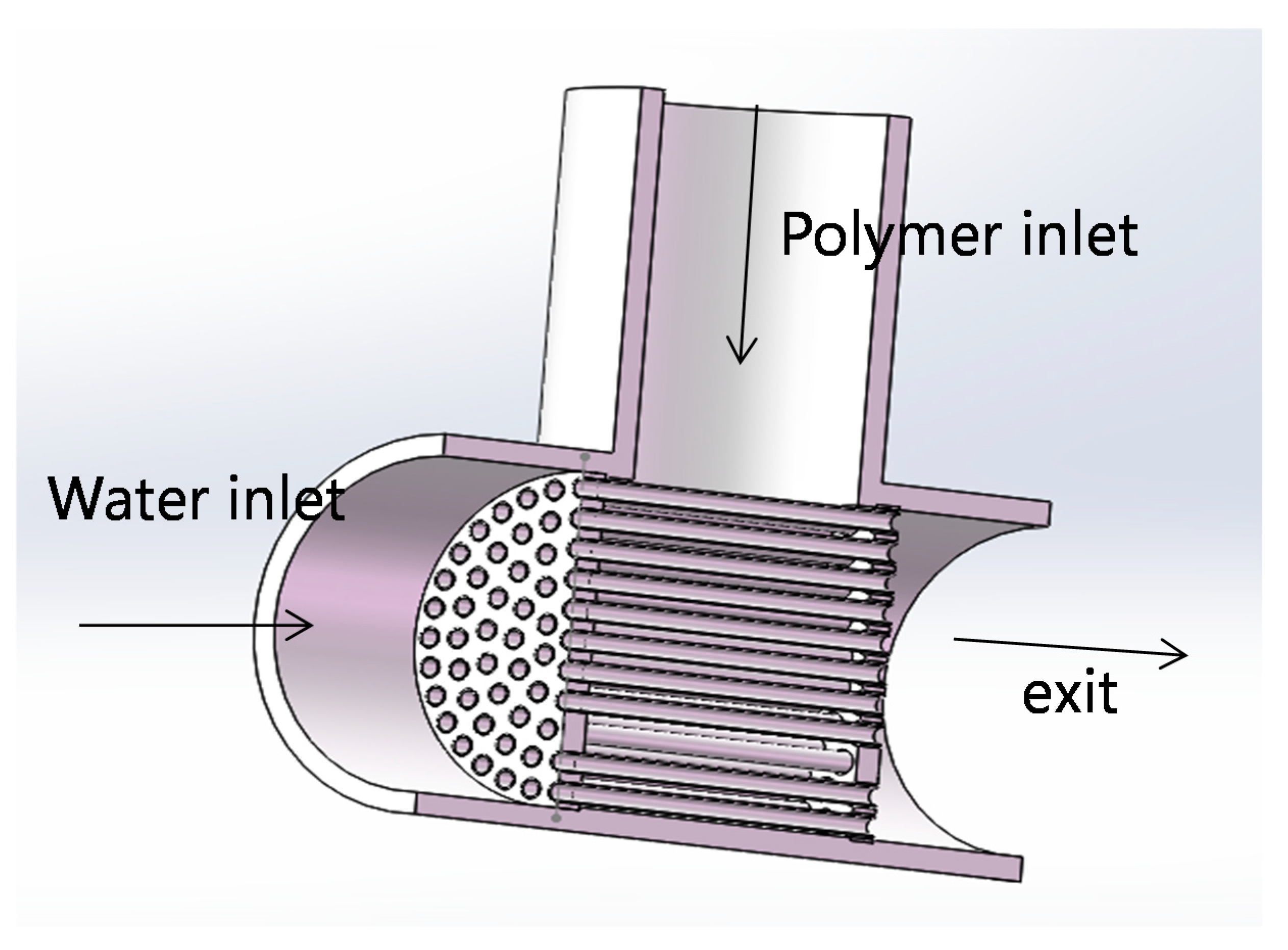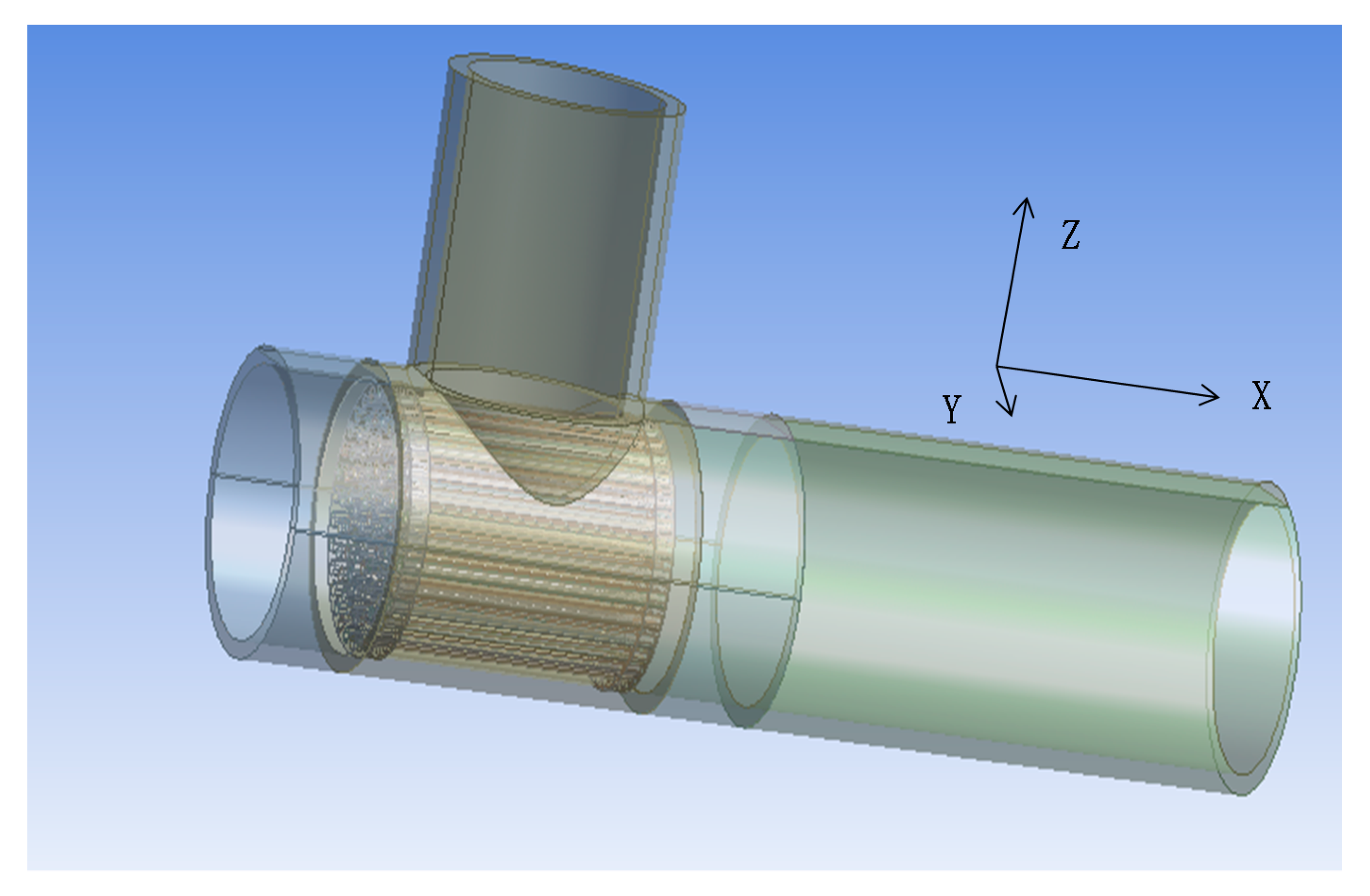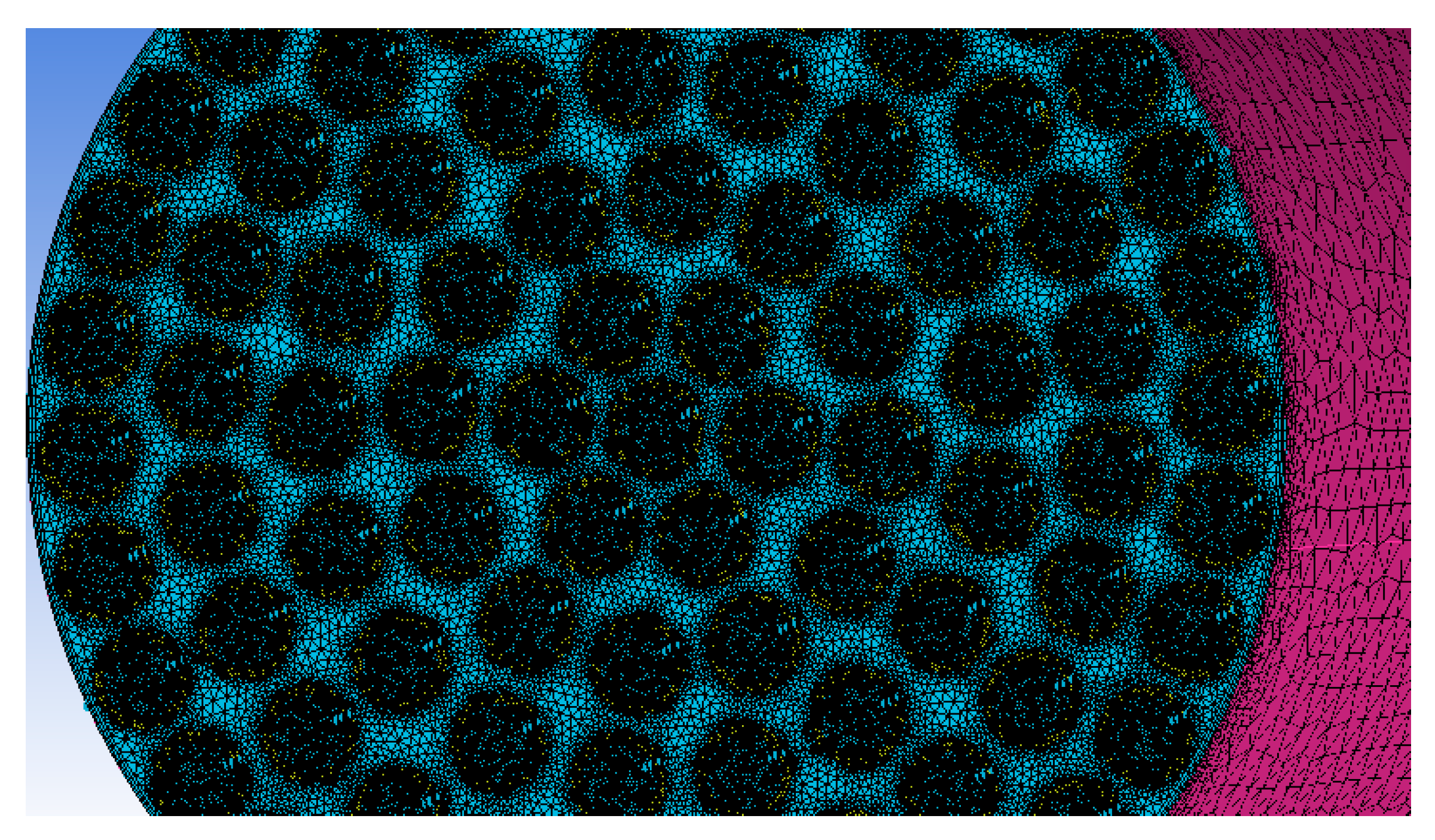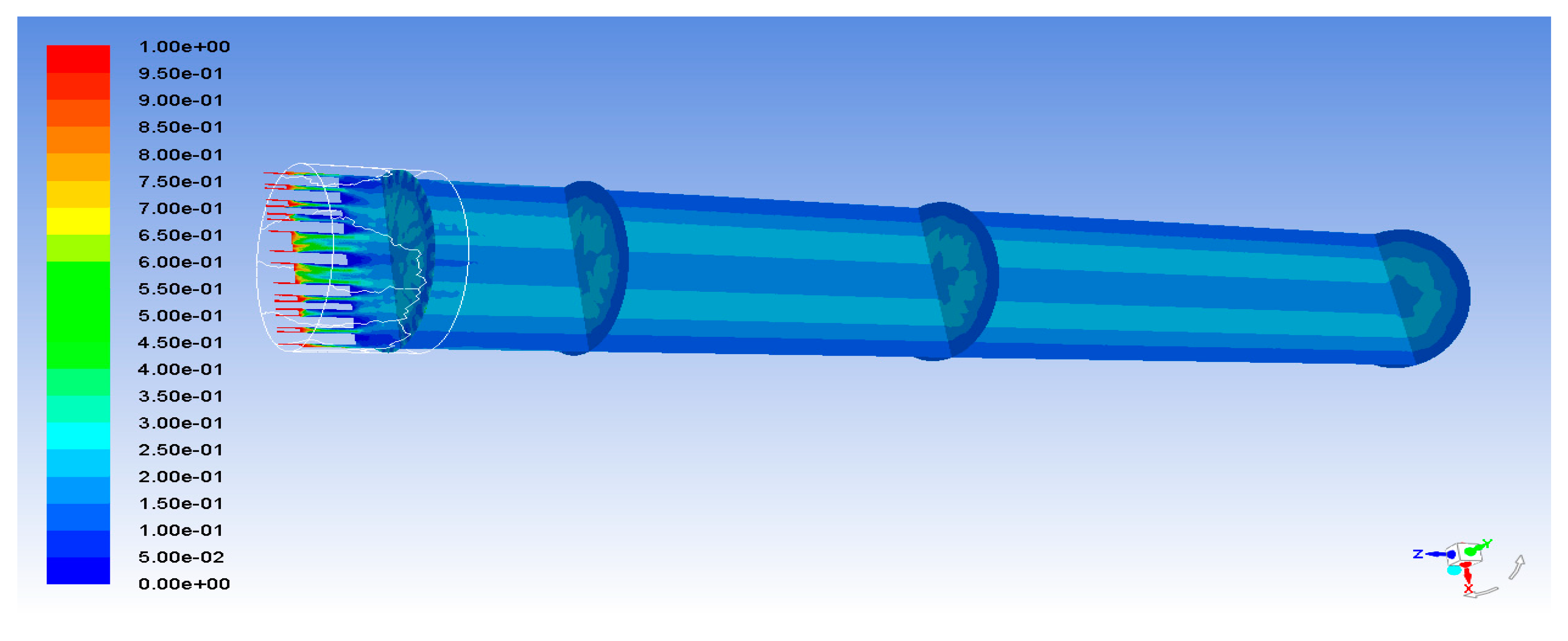Optimization Design and Analysis of Polymer High Efficiency Mixer in Offshore Oil Field
Abstract
1. Introduction
2. Design of High-Efficiency Mixer
2.1. Design Idea
2.2. Numerical Modeling and Parameters
- (1)
- Constant mass flow is adopted as the boundary condition at the entrance boundary. According to the actual situation of the current injection concentration and injection amount of the polymer in the mine, the injected flow of polymer solution when it meets water is set at 75 m3/D, and the viscosity of the polymer solution at 5000 mg/L is 4000 mPa·s, and the injected flow of dilution water is 325 m3/D, and the viscosity of the water solution is 1 mPa·s.
- (2)
- The outlet boundary condition is constant pressure boundary condition, and the pressure is standard atmospheric pressure.
- (3)
- The no-slip condition is considered as the solid wall boundary condition, and the viscous sublayer is processed by the standard wall function.
- (4)
- Relaxation parameters: this is the default relaxation factor, and the convergence precision is the double precision.
- (5)
- Calculation residual: the calculation residual is less than 10−3, and it mainly monitors whether the outlet volume fraction is balanced as the basis for the calculation to reach stability.
- (6)
- Grid independence: the grid independence is verified, finally, the grid number is 15 million.
- (7)
- Discretization schemes: discrete format adopts the default simple algorithm.
2.3. Physical and Mathematical Modeling
2.3.1. Physical Model
2.3.2. Mathematical Model
3. Results and Discussion
3.1. Mixing Effect of High-Efficiency Mixer
3.2. Optimization of High-Efficiency Mixer
3.2.1. Design Idea and Model Optimization
3.2.2. Mixing Effect after Optimization
3.2.3. Influence of Different Pore-Opening Schemes
4. Conclusions
Author Contributions
Funding
Conflicts of Interest
References
- James, J.S.; Bernd, L.; Nasser, A. Status of Polymer-Flooding Technology. J. Can. Pet. Technol. 2015, 54, 116–126. [Google Scholar]
- Lyadova, N.A.; Raspopov, A.V.; Bondarenko, A.V.; Kovalevskiy, A.I.; Cherepanov, S.S.; Baldina, T.R. Perspective application of the polymer flooding technology in the Perm region oil deposits (Russian). Oil Ind. J. 2016, 2016, 94–96. [Google Scholar]
- Lederer, C.; Altstadt, S.; Andriamonje, S.; Andrzejewski, J.; Audouin, L.; Barbagallo, M.; Bécares, V.; Becvár, F.; Belloni, F.; Berthier, B.; et al. Society of Petroleum Engineers—SPE EOR Conference at Oil and Gas West Asia 2012, OGWA—EOR: Building Towards Sustainable Growth. In Proceedings of the SPE EOR Conference at Oil and Gas West Asia 2012—EOR: Building towards Sustainable Growth, OGWA Muscat, Oman, 16–18 April 2012. [Google Scholar]
- Fan, H.J. Process Evaluation of the Colloid Injection and Allocation for Polyacrylamide. Oil Gas Field Surf. Eng. 2019, 8, 105–107. [Google Scholar]
- Demin, W.; Youlin, J.; Yan, W.; Xiaohong, G.; Gang, W. Viscous-elastic polymer fluids rheology and its effect upon production equipment. SPE Prod. Facil. 2005, 19, 209–216. [Google Scholar] [CrossRef]
- Jiang, W.C.; Zhang, J.; Song, K.P.; Tang, E.G.; Huang, B. Study on the Surfactant/Polymer Combination Flooding Relative Permeability Curves in Offshore Heavy Oil Reservoirs. Adv. Mater. Res. 2014, 53, 887–888. [Google Scholar] [CrossRef]
- Jiang, H.; Chen, F.; Li, Y.; Zheng, W.; Sun, L. A Novel Model to Evaluate the Effectiveness of Polymer Flooding in Offshore Oilfield. In Proceedings of the Offshore Technology Conference-Asia, Kuala Lumpur, Malaysia, 25–28 March 2015. [Google Scholar]
- Pi, Y.F.; Liu, J.J.; Xu, S.U. A Study of the Displacement Efficiency and Swept Efficiency to Enhance Oil Recovery. Int. J. Simul. Syst. Sci. Technol. 2016, 17, 19.1–19.6. [Google Scholar]
- Zhang, C.; Ye, Z.B.; Shi, L.T.; Zhao, W.S.; Zhang, Z. A study on the mechanism to build flow resistance by hydrophobic associated polymer. China Offshore Oil Gas 2007, 19, 251–253. [Google Scholar]
- Xie, K.; Cao, B.; Lu, X.; Jiang, W.; Zhang, Y.; Li, Q.; Song, K.; Liu, J.; Wang, W.; Lv, J.; et al. Matching between the diameter of the aggregates of hydrophobically associating polymers and reservoir pore-throat size during polymer flooding in an offshore oilfield. J. Pet. Sci. Eng. 2019, 177, 558–569. [Google Scholar] [CrossRef]
- Xie, K.; Lu, X.; Li, Q.; Jiang, W.; Yu, Q. Analysis of Reservoir Applicability of Hydrophobically Associating Polymer. SPE J. 2016, 21, 1–9. [Google Scholar] [CrossRef]
- Chen, H.; Wang, Z.M.; Ye, Z.B.; Han, L.J. The solution behavior of hydrophobically associating zwitterionic polymer in salt water. J. Appl. Polym. Sci. 2014, 131. [Google Scholar] [CrossRef]
- Zhang, R.; Ye, Z.; Peng, L.; Qin, N.; Shu, Z.; Luo, P. The shearing effect on hydrophobically associative water-soluble polymer and partially hydrolyzed polyacrylamide passing through wellbore simulation device. J. Appl. Polym. Sci. 2013, 127, 682–685. [Google Scholar] [CrossRef]
- Zhu, Y.J.; Zhang, J.; Zhao, W.S.; Wang, S.S.; Jing, B.; Meng, F.X.; Zhang, H. Research on Efficient Polymer Dissolving Technology for Hydrophobically Associating Polymer Flooding on Offshore Platform. In Proceedings of the 4th International Conference on Applied Mechanics, Materials and Manufacturing (ICAMMM), Shenzhen, China, 23–24 August 2014. [Google Scholar]
- Xie, M.H.; Zhou, G.Z.; Liu, M.; Wu, H.; Long, X.L.; Yu, P.Q. Solubility of Hydrophobic Associating Polymer AP-P4 in Stirred Tank. J. East China Univ. Sci. Technol. (Nat. Sci. Ed.) 2010, 36, 323–333. [Google Scholar]
- Chen, X. Screening and Evaluation of the Polymer Profile Control and Flooding System in Offshore Oil Field. Master’s Thesis, Northeast Petroleum University, Daqing, China, 2015. [Google Scholar]
- Lu, Q. Study on the interaction between cyclodextrin and hydrophobically associating polymer. Master’s Thesis, Southwest Petroleum University, Chengdu, China, 2015. [Google Scholar]
- Liu, L.W.; Zhang, J. Study on the Fast Dissolution of a Hydrophobic Association Water-Soluble Polymer. J. Southwest Pet. Univ. 2012, 3, 157–162. [Google Scholar]
- Wang, Y.; Ye, Z.B.; Shu, Z.; Pu, J. A study on accelerating the solubility of hydrophobically associate polymer for offshore oilfield. Offshore Oil 2007, 2, 42–44. [Google Scholar]
- Shi, Y. Study on Relationship between Solubility and Injection of New Polymer. Master’s Thesis, China Petroleum Exploration and Development Research Institute, Beijing, China, 2005. [Google Scholar]
- Peter, G.M.K.; Shanmugasundaram, S. Polymer Melt Mixing in Static Mixers. In The Encyclopedia of Materials: Science and Technology; Elsevier: Amsterdam, The Netherlands, 2001; pp. 7428–7430. [Google Scholar]
- Demoz, A. Scaling inline static mixers for flocculation of oil sand mature fine tailings. AIChE J. 2015, 61, 4402–4411. [Google Scholar] [CrossRef]
- Liu, R.; Yuan, D.; Wang, Y.; Wang, J.; Jin, Y. Experimental study on a new tipe Static Mixer using in EOR injection polymer. Chem. Ind. Eng. Prog. 2011, 30, 475–478. [Google Scholar]
- Newswire, P.R. Komax Hi-Pass Static Mixer Achieves More Than 25% Polymer Savings; PR Newswire: New York, NY, USA, 2018. [Google Scholar]
- Ruphuy, G.; Weide, T.; Lopes, J.C.B.; Dias, M.M.; Barreiro, M.F. Preparation of nano-hydroxyapatite/chitosan aqueous dispersions: From lab scale to continuous production using an innovative static mixer. Carbohydr. Polym. 2018, 202, 20–28. [Google Scholar] [CrossRef]
- Gholamali, F.; Elodie, B.; Timothy, F.L.M. Miniemulsions using static mixers: A feasibility study using simple in-line static mixers. J. Appl. Polym. Sci. 2009, 114, 3875–3881. [Google Scholar] [CrossRef]
- Zhou, G.Z.; Xie, M.H.; Liu, M.; Wu, H.; Long, X.L.; Yu, P.Q. Dissolution Characteristics of Hydrophobically Associating Polyacrylamide in Stirred Tanks. Chin. J. Chem. Eng. 2010, 18, 170–174. [Google Scholar] [CrossRef]
- Liu, M.; Zou, M.H.; Qiu, W.; Chao, S.Q.; Guo, P.W. High-efficient dissolution process design for polymer and its application in Bohai Oilfield. Pet. Eng. Constr. 2019, 45, 30–34. [Google Scholar]
- Yu, Q.; Lu, X.G.; Zhang, D.F.; Xie, K. Accelerating Dissolution of Polyacrylamide in Offshore Oil Field. Bull. Korean Chem. Soc. 2015, 36, 2516–2520. [Google Scholar] [CrossRef]
- Guo, G.F.; Ye, Z.B.; Shu, Z. Effects of Near Wellbore Shearing on the Seepage Characteristics of Flooding Polymer Solutions. Oilfield Chem. 2014, 1, 90–94. [Google Scholar]
- Lederer, C.; Altstadt, S.; Andriamonje, S.; Andrzejewski, J.; Audouin, L.; Barbagallo, M.; Bécares, V.; Becvár, F.; Belloni, F.; Berthier, B.; et al. The effect of injection rate on recovery behaviors of hydrohobically water-soluble polymers after shearing. In Proceedings of the 16th International Conference on Fundamental Approaches to Software Engineering, FASE 2013, Held as Part of the European Joint Conferences on Theory and Practice of Software, ETAPS 2013, Rome, Italy, 16–24 March 2013. [Google Scholar]
- Liu, Y.G.; Chen, H.X.; Tang, H.M.; Feng, Y.T.; Pang, M. Mechanism of scaling on reservoir formation damage by polymer-containing wastewater re-injection. Desalin. Water Treat. 2019, 139, 7–13. [Google Scholar] [CrossRef]
- Guo, Y.; Hu, J.; Zhang, X.; Feng, R.; Li, H. Flow Behavior Through Porous Media and Microdisplacement Performances of Hydrophobically Modified Partially Hydrolyzed Polyacrylamide. SPE J. 2016, 21, 688–705. [Google Scholar] [CrossRef]
- Ye, Z.B.; Wang, X.Y.; Shu, Z. Effect of shearing on the hydrodynamic radius distribution characteristics of polymer solution. Chem. Res. Appl. 2016, 28, 1268–1274. [Google Scholar]
- Siregar, R.E.K.; Syam, B.; Wirjosentono, B.; Muttaqin, M. Static simulation to horse shoes alternative materials based basic polymeric foam reinforced fiberglass with ANSYS software. J. Phys. Conf. Ser. 2018, 1116, 42036. [Google Scholar] [CrossRef]
- Wilcox, D.C. Reassessment of the scale-determing equation for advanced turbulence models. AIAA J. 1988, 26, 1299–1310. [Google Scholar] [CrossRef]
- Pan, C.T.; Wang, S.Y.; Yen, C.K.; Ho, C.K.; Yen, J.F.; Chen, S.W.; Fu, F.R.; Lin, Y.T.; Lin, C.H.; Kumar, A.; et al. Study on Delamination Between Polymer Materials and Metals in IC Packaging Process. Polymers 2019, 11, 940. [Google Scholar] [CrossRef]
- Cui, Z.D.; Liu, B.; Cai, J.; Huai, X.L. Analysis of simulation results for cavitating flows in micro-channels using different turbulence models. J. Univ. Chin. Acad. Sci. 2016, 33, 213–217. [Google Scholar]
- Sahu, Y.K. Study on the Effective Thermal Conductivity of Fiber Reinforced Epoxy Composites. Master’s Thesis, National Institute of Technology, Rourkela, Odisha, India, 2014. [Google Scholar]
- Murali, B.; Ramnath, B.V.; Chandramohan, D. Crash Test Analysis on Natural Fiber Composite Materials for Head Gear. Indian J. Sci. Technol. 2017, 10, 1–5. [Google Scholar] [CrossRef]
- Malecha, Z.M.; Malecha, K. Numerical analysis of mixing under low and high frequency pulsations at serpentine micromixers. Chem. Process. Eng. 2014, 35, 369–385. [Google Scholar] [CrossRef]












| Experimental Condition | Caliber Size mm | Viscosity of Polymer Solution mPa·s |
|---|---|---|
| Using formation water (total mineralization is 9300 mg/L [31,32]) from SZ36-1 oilfield in Bohai Sea to prepare polymer solution AP-P4 with concentration of 1750 mg/L [33]. The apparent viscosity of the solution was measured after passing through different sizes of pipe diameter at the injection rate of 10 mL/min. | 20 | 161.25 |
| 10 | 159.35 | |
| 8 | 157.21 | |
| 7 | 155.33 | |
| 6 | 124.71 | |
| 5 | 95.98 | |
| 4 | 47.32 | |
| 3 | 24.64 | |
| 2 | 15.32 | |
| 1 | 9.683 |
© 2020 by the authors. Licensee MDPI, Basel, Switzerland. This article is an open access article distributed under the terms and conditions of the Creative Commons Attribution (CC BY) license (http://creativecommons.org/licenses/by/4.0/).
Share and Cite
Shu, Z.; Zhu, S.; Zhang, J.; Zhao, W.; Ye, Z. Optimization Design and Analysis of Polymer High Efficiency Mixer in Offshore Oil Field. Processes 2020, 8, 110. https://doi.org/10.3390/pr8010110
Shu Z, Zhu S, Zhang J, Zhao W, Ye Z. Optimization Design and Analysis of Polymer High Efficiency Mixer in Offshore Oil Field. Processes. 2020; 8(1):110. https://doi.org/10.3390/pr8010110
Chicago/Turabian StyleShu, Zheng, Shijie Zhu, Jian Zhang, Wensen Zhao, and Zhongbin Ye. 2020. "Optimization Design and Analysis of Polymer High Efficiency Mixer in Offshore Oil Field" Processes 8, no. 1: 110. https://doi.org/10.3390/pr8010110
APA StyleShu, Z., Zhu, S., Zhang, J., Zhao, W., & Ye, Z. (2020). Optimization Design and Analysis of Polymer High Efficiency Mixer in Offshore Oil Field. Processes, 8(1), 110. https://doi.org/10.3390/pr8010110





